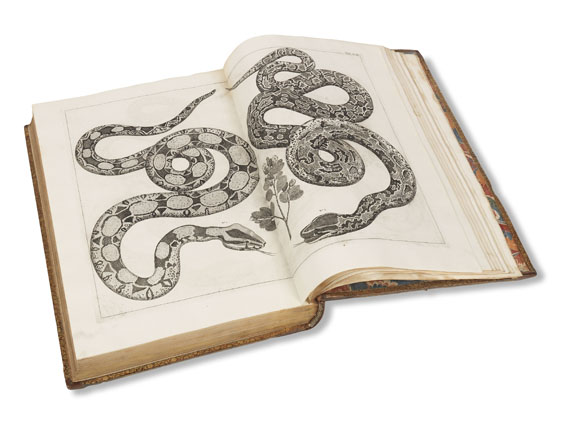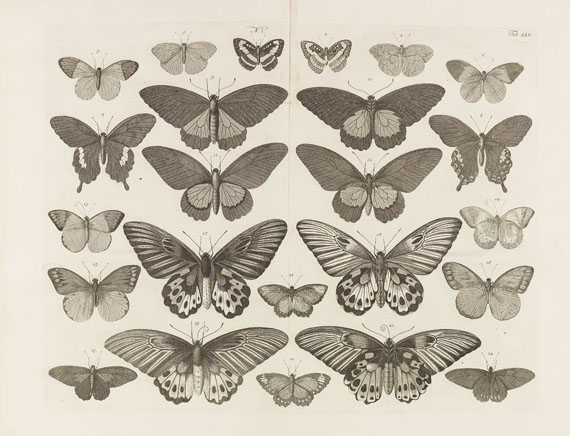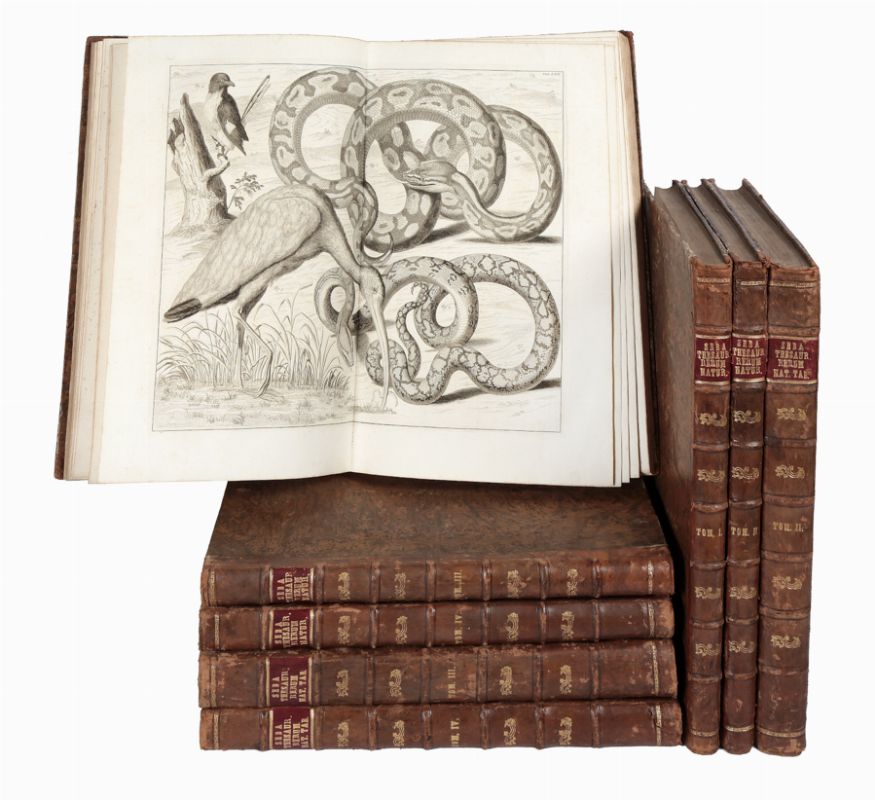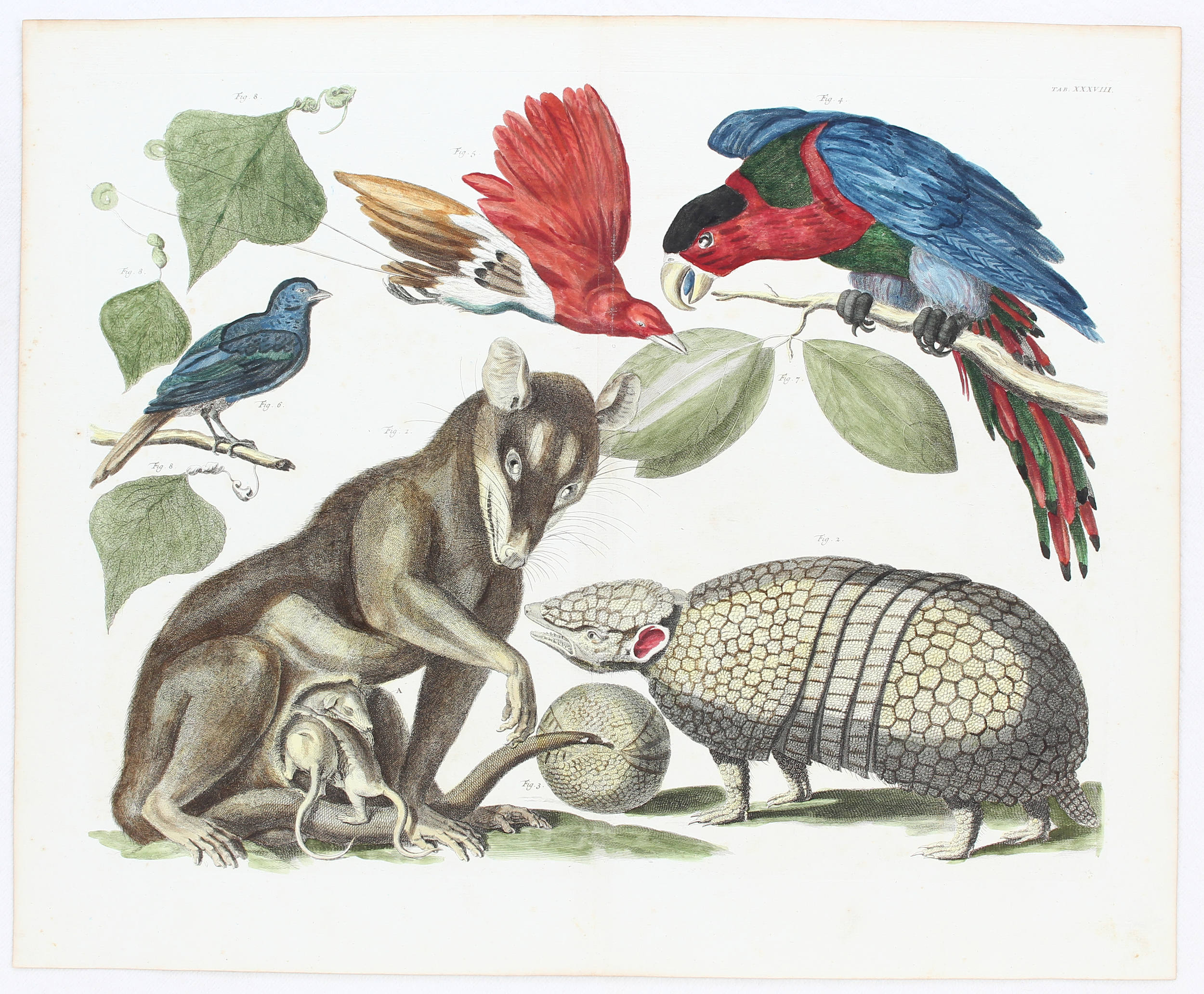Locupletissimi rerum naturalium thesauri accurata descriptio, et iconibus artificiosissimis expressio, per universam physices historiam.
Amsterdam: Jansson-Waesberg, J. Wetsen and William Smith [vols.I & II]; Jansson-Waesberg [vol.III]; H.C. Arkesteum & H. Merkum, Peter Schouten [vol.IV], 1734-1735-1758-1765. 4 volumes, folio (540 x 364 mm). Text in Latin and French, half-titles in French, titles in Latin printed in red and black with engraved vignettes, that in vol.I hand-colored, 5 uncolored engraved head-pieces by Pieter Tanjé. Engraved portrait of Seba after J.M. Quinkard by J. Houbraken, engraved frontispiece after Louis Fabritius Dubourg by Tanjé, 449 etched plates (175 double-page) by Tanjé, Adolf van der Laan Frans de Bakker, A. van Buysen, de la Croix, J. Folkema, W. Jongman, F. Morellon, Jan Punt and others, all with fine contemporary hand-coloring in the style of the colorist J. Fortuyn of the Hague. Late 18th-century French? dark blue half straight-grained morocco over dark blue paper-covered boards, covers with gilt roll-tool borders, spine in eight compartments with raised bands, the bands highlighted with a gilt roll tool and flanked by gilt fillets, lettered in the second and numbered in the fourth compartment, the remaining compartments with repeat decoration of interlocking circles, joined curves, small circles, small palmette tools and pointillé work, marbled endpapers, uncut. Condition : volume IV with discoloration to upper blank margin of plate number XXIV, plate LIX with old repair to 75mm. tear to right margin affecting the image area, plate XC with small sections of the tissue guard adhering to the plate surface; bindings worn with extremities rubbed with loss, joints split or rubbed, spines chipped at head and foot, some with loss, six inner hinges split. Provenance : pencilled price of 30,000 roubles for the four ‘tomes’ at front of vol.I; St. Petersburg bookshop, store number 53 (label at end of vol.I, with a price of 400 roubles, and a possible date ‘4/61’). first edition, french-latin issue, of one of the greatest of all 18th-century illustrated natural history books: an exceptional copy, completely uncut, with spectacular contemporaray hand coloring in the style of the j.fortuyn of the hague. Albertus Seba, an Amsterdam apothecary, formed two of the most famous 18th-century natural history collections. The first was bought by Czar Peter the Great in 1717 following his visit to Amsterdam. Seba used the 15,000 gilders that the purchase raised to begin forming what ended up being an even more extensive collection. Amsterdam's position as an European center for overseas trade facilitated Seba’s collecting, as did his friendship with the director of the Dutch West India company. He had also built up a network of foreign contacts in Ceylon, Virginia, Arabia, Greenland, and elsewhere, and was a leading figure in the international scientific community, opening his cabinet to scholars and scientists and corresponding with men such as Hans Sloane, J.J. Scheuchzer, L. Marsigli, and, most closely, with Linneaus. Towards the end of his life Seba conceived the idea of this work: a permanent record of a great collection, and, as it turned out, a memorial to a great collector. The first step which led to the present publication was taken in October 1731 when Seba signed a contract with publishers to produce a four-volume work, with 400 plates. In the event, only the first two volumes, published in 1734 and 1735, had appeared by the time of Seba’s death in 1736. He wrote the majority of the text for these voumes himself, but did also get help from other naturalists: Frederik Ruysch identified a number of the snakes, and the commentary on the fish in the third volume is by Peter Artedi (1705-1735). A publication of this size was a major undertaking - 13 artists were involved in the production of the plates - and its production stalled following Seba’s death, but , helped by the sale of the collection at auction in April 1752, the third volume was eventually published in 1758 and using Seba’s original notes, the final volume appeared in 1765. In th
Locupletissimi rerum naturalium thesauri accurata descriptio, et iconibus artificiosissimis expressio, per universam physices historiam.
Amsterdam: Jansson-Waesberg, J. Wetsen and William Smith [vols.I & II]; Jansson-Waesberg [vol.III]; H.C. Arkesteum & H. Merkum, Peter Schouten [vol.IV], 1734-1735-1758-1765. 4 volumes, folio (540 x 364 mm). Text in Latin and French, half-titles in French, titles in Latin printed in red and black with engraved vignettes, that in vol.I hand-colored, 5 uncolored engraved head-pieces by Pieter Tanjé. Engraved portrait of Seba after J.M. Quinkard by J. Houbraken, engraved frontispiece after Louis Fabritius Dubourg by Tanjé, 449 etched plates (175 double-page) by Tanjé, Adolf van der Laan Frans de Bakker, A. van Buysen, de la Croix, J. Folkema, W. Jongman, F. Morellon, Jan Punt and others, all with fine contemporary hand-coloring in the style of the colorist J. Fortuyn of the Hague. Late 18th-century French? dark blue half straight-grained morocco over dark blue paper-covered boards, covers with gilt roll-tool borders, spine in eight compartments with raised bands, the bands highlighted with a gilt roll tool and flanked by gilt fillets, lettered in the second and numbered in the fourth compartment, the remaining compartments with repeat decoration of interlocking circles, joined curves, small circles, small palmette tools and pointillé work, marbled endpapers, uncut. Condition : volume IV with discoloration to upper blank margin of plate number XXIV, plate LIX with old repair to 75mm. tear to right margin affecting the image area, plate XC with small sections of the tissue guard adhering to the plate surface; bindings worn with extremities rubbed with loss, joints split or rubbed, spines chipped at head and foot, some with loss, six inner hinges split. Provenance : pencilled price of 30,000 roubles for the four ‘tomes’ at front of vol.I; St. Petersburg bookshop, store number 53 (label at end of vol.I, with a price of 400 roubles, and a possible date ‘4/61’). first edition, french-latin issue, of one of the greatest of all 18th-century illustrated natural history books: an exceptional copy, completely uncut, with spectacular contemporaray hand coloring in the style of the j.fortuyn of the hague. Albertus Seba, an Amsterdam apothecary, formed two of the most famous 18th-century natural history collections. The first was bought by Czar Peter the Great in 1717 following his visit to Amsterdam. Seba used the 15,000 gilders that the purchase raised to begin forming what ended up being an even more extensive collection. Amsterdam's position as an European center for overseas trade facilitated Seba’s collecting, as did his friendship with the director of the Dutch West India company. He had also built up a network of foreign contacts in Ceylon, Virginia, Arabia, Greenland, and elsewhere, and was a leading figure in the international scientific community, opening his cabinet to scholars and scientists and corresponding with men such as Hans Sloane, J.J. Scheuchzer, L. Marsigli, and, most closely, with Linneaus. Towards the end of his life Seba conceived the idea of this work: a permanent record of a great collection, and, as it turned out, a memorial to a great collector. The first step which led to the present publication was taken in October 1731 when Seba signed a contract with publishers to produce a four-volume work, with 400 plates. In the event, only the first two volumes, published in 1734 and 1735, had appeared by the time of Seba’s death in 1736. He wrote the majority of the text for these voumes himself, but did also get help from other naturalists: Frederik Ruysch identified a number of the snakes, and the commentary on the fish in the third volume is by Peter Artedi (1705-1735). A publication of this size was a major undertaking - 13 artists were involved in the production of the plates - and its production stalled following Seba’s death, but , helped by the sale of the collection at auction in April 1752, the third volume was eventually published in 1758 and using Seba’s original notes, the final volume appeared in 1765. In th
.jpg)













.jpg?height=400)
Try LotSearch and its premium features for 7 days - without any costs!
Be notified automatically about new items in upcoming auctions.
Create an alert